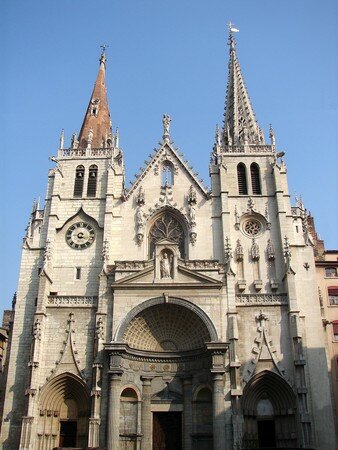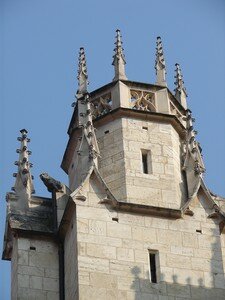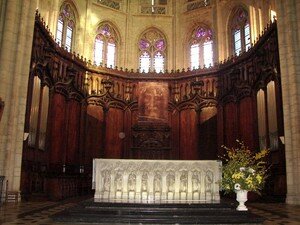St Nizier
 The
first religious building located on the site of the current church is a
Roman monument, probably a temple of Attis. Attis or Atys is a divinity
of Phrygian origin, parèdre of the Cybèle goddess, of which he is at
the same time the son and the lover. It can be compared with Adonis,
parèdre of Aphrodite-Astarté, or Tammuz, parèdre of Ishtar. Its worship
with mysteries was spread in Greece, then in all the Roman Empire. The
monuments represent Attis as a Phrygian shepherd, with the bonnet, the
stick of the shepherd, the syrinx and the tympanon, its costume
sticking leaving the belly to overdraft. It carries typically Persian
trousers (anaxyrides). One of its emblems is the cock (Wales), because
Attis was the first of Wales. One also sees it with Cybèle, in the same
tank trailed by lions. The faithful ones of Attis would have played a
part in persecution antichrétienne of 177.
The
first religious building located on the site of the current church is a
Roman monument, probably a temple of Attis. Attis or Atys is a divinity
of Phrygian origin, parèdre of the Cybèle goddess, of which he is at
the same time the son and the lover. It can be compared with Adonis,
parèdre of Aphrodite-Astarté, or Tammuz, parèdre of Ishtar. Its worship
with mysteries was spread in Greece, then in all the Roman Empire. The
monuments represent Attis as a Phrygian shepherd, with the bonnet, the
stick of the shepherd, the syrinx and the tympanon, its costume
sticking leaving the belly to overdraft. It carries typically Persian
trousers (anaxyrides). One of its emblems is the cock (Wales), because
Attis was the first of Wales. One also sees it with Cybèle, in the same
tank trailed by lions. The faithful ones of Attis would have played a
part in persecution antichrétienne of 177.
 According
to the legend, a new sanctuary, in 150, was built on the site of the
Roman monument, (which one still sees the columns in front of the
frontage on the plan of XVIeme century), by Saint Pothin. It is a place
of worship which it dedicates to the virgin. Saint Pothin was the first
bishop of Lyon and the first bishop of Gaule. Resulting from a
community from Raising in Phrygie, it was stopped at the same time as
holy Blandine and than a group of Christians under the reign of Marc
Aurèle into 177. They are known under the name of Martyrs of Lyon.
Saint Pothin dies in prison probably on June 2 following the ill
treatments inflicted by his torturers. Saint Irenee succeeded to him.
According
to the legend, a new sanctuary, in 150, was built on the site of the
Roman monument, (which one still sees the columns in front of the
frontage on the plan of XVIeme century), by Saint Pothin. It is a place
of worship which it dedicates to the virgin. Saint Pothin was the first
bishop of Lyon and the first bishop of Gaule. Resulting from a
community from Raising in Phrygie, it was stopped at the same time as
holy Blandine and than a group of Christians under the reign of Marc
Aurèle into 177. They are known under the name of Martyrs of Lyon.
Saint Pothin dies in prison probably on June 2 following the ill
treatments inflicted by his torturers. Saint Irenee succeeded to him.
 At
the 5th century, according to the tradition, Holy Eucher, 19th bishop
of Lyon, builds on the ruins of the building a basilica to shelter the
relics of the first 48 martyrs of Lyon, among which holy Pothin and
holy Blandine.
At
the 5th century, according to the tradition, Holy Eucher, 19th bishop
of Lyon, builds on the ruins of the building a basilica to shelter the
relics of the first 48 martyrs of Lyon, among which holy Pothin and
holy Blandine.
The church receives the name of “church of the Saints Apostles”, namely Pierre and Paul. The bishops of Lyon are made there bury during all VIème century, in particular holy Nizier, 28th bishop. The body of saint Nizier, uncle de Grégoire de Tours, buried into 573, gave place immediately to many miracles. Gregoire devotes to him several chapters of the Liber vitae patrum.
 From
these texts one can draw a description of the tomb of Nizier Saint who
must be in good place in the church and elevated since a blind man is
cured while placing himself under the coffin. Very quickly a worship of
this saint bishop of Lyon it is developed so much so that the church
ends up taking its name. The body of this last attracts a so large
crowd, the miracles that one lends to him are so numerous that the
church ends up taking its name.
From
these texts one can draw a description of the tomb of Nizier Saint who
must be in good place in the church and elevated since a blind man is
cured while placing himself under the coffin. Very quickly a worship of
this saint bishop of Lyon it is developed so much so that the church
ends up taking its name. The body of this last attracts a so large
crowd, the miracles that one lends to him are so numerous that the
church ends up taking its name.
 In
first half of VIIIème century, holy Nizier, like the other Lyons
churches, is devastated by incursions of Sarassins going up the valley
of the Rhone then by the brutal reconquests of Charles Martel. It is
rebuilt only in IXème century, on the order of the bishop Leidrade,
friend of Charlemagne, which associates a canonic chapter to him. It is
then a small Romance church with bell-tower that one can see on a seal
going back to 1271, and as in any chapter, the life is organized around
a cloister. This cloister was located at the south of the church,
between this one and the street Poulaillerie. It was to have
approximately 15 meters on side.
In
first half of VIIIème century, holy Nizier, like the other Lyons
churches, is devastated by incursions of Sarassins going up the valley
of the Rhone then by the brutal reconquests of Charles Martel. It is
rebuilt only in IXème century, on the order of the bishop Leidrade,
friend of Charlemagne, which associates a canonic chapter to him. It is
then a small Romance church with bell-tower that one can see on a seal
going back to 1271, and as in any chapter, the life is organized around
a cloister. This cloister was located at the south of the church,
between this one and the street Poulaillerie. It was to have
approximately 15 meters on side.
The district of the church embourgeoise, from now on the election of the consuls and aldermen is proclaimed there. Pierre Valdo, in XIIIème century, is the parishioner. Its disciples, the of Vaud ones, shocked by the richness of the places, put fire at the church in 1253.
The archbishop Louis de Villars undertakes the construction of the current church in XIVème century, with the assistance of the middle-class men who wish to have their own church in the peninsula (the primatiale Midsummer's Day is in the course of completion on other bank of the Saone).
 It
melts in 1306 a collegial chapître, i.e. a college of canons intended
to hold the church and to ensure the divine office it. It starts with
the chorus, in the east, like wants it the tradition. Work advances
gradually, and the church is completed only at the end of XVIème
century.
It
melts in 1306 a collegial chapître, i.e. a college of canons intended
to hold the church and to ensure the divine office it. It starts with
the chorus, in the east, like wants it the tradition. Work advances
gradually, and the church is completed only at the end of XVIème
century.
It undergoes the damage caused by the bands huguenotes of
the area, which plundered the tombs of the bishops of Lyon, then those
of the French revolution.
 This
blazing monument of Gothic style already announces by place the
Rebirth. Construction took place by stages, of the chorus to the
frontage, XIVème century and XVIème century for the whole of the
central nave, the side aisles and their voûtements, as well as side
chapels. The Northern bell-tower with its pink brick arrow is high in
the middle of XVème century. It is only the end of XVIème century which
the Benoit architect completes the frontage by the construction of the
Gothic pinion above the central gate and the Southern bell-tower in
1856.
This
blazing monument of Gothic style already announces by place the
Rebirth. Construction took place by stages, of the chorus to the
frontage, XIVème century and XVIème century for the whole of the
central nave, the side aisles and their voûtements, as well as side
chapels. The Northern bell-tower with its pink brick arrow is high in
the middle of XVème century. It is only the end of XVIème century which
the Benoit architect completes the frontage by the construction of the
Gothic pinion above the central gate and the Southern bell-tower in
1856.
 On
a wall of the crypt, a fragment of the epitaph of Sacerdos saint,
bishop of Lyon (549-552). Always in the crypt one can admire a first
statue of Notre-Dame de Grâce of XVIème century.
On
a wall of the crypt, a fragment of the epitaph of Sacerdos saint,
bishop of Lyon (549-552). Always in the crypt one can admire a first
statue of Notre-Dame de Grâce of XVIème century.
 The
first crypt was destroyed in 1883. Thanks to an investigation going
back to 1308, we know that it contained the tombs of the bishops and
their epitaphs.
The
first crypt was destroyed in 1883. Thanks to an investigation going
back to 1308, we know that it contained the tombs of the bishops and
their epitaphs.
 Descriptions
of 1883 are rather precise: the central square of 4m on side is
surrounded by 4 absidioles of 2,50m of diameter. A tomb in the shape of
trough appears with the birth of a vault. Side staircases give access
to the chorus.
Descriptions
of 1883 are rather precise: the central square of 4m on side is
surrounded by 4 absidioles of 2,50m of diameter. A tomb in the shape of
trough appears with the birth of a vault. Side staircases give access
to the chorus.
 The
plan of the church is characteristic of XIVème and the blazing Gothic:
3 levels of rise with a triforium, 3 naves, a transept, an apse and 2
absidioles, 9 side chapels, vast bays and finely decorated Gothic
vaults.
The
plan of the church is characteristic of XIVème and the blazing Gothic:
3 levels of rise with a triforium, 3 naves, a transept, an apse and 2
absidioles, 9 side chapels, vast bays and finely decorated Gothic
vaults.
Its dimensions are impressionantes for a parish church: 74m length, 28 of width and 29 height.
Outside, one admires the arcs paring on the side walls north and south. The blocks of limestone of the low part of the building come partly from recoveries of the Roman city of Lugdunum on the hill of Fourvière.
Saint Nizier is the only church of Lyon having two bell-towers.
Posed outside the apse, a hairy man questions himself: what to make to leave the animality?
 George
Prat made a geobiologic study of the égise. He finds two chimneys
cosmo-telluric, one with transept crossing and the other in the vault
of the baptismal funds. in the axis of the church, a current of subsoil
water of the width of the principal door. On the site of the furnace
bridge, cross this current, another current as well as a fault. Another
current is used as the Jordan. The weakness of telluric energy was
paliée by the addition of beds of rollers (blue bands) which act like
current water truths.
George
Prat made a geobiologic study of the égise. He finds two chimneys
cosmo-telluric, one with transept crossing and the other in the vault
of the baptismal funds. in the axis of the church, a current of subsoil
water of the width of the principal door. On the site of the furnace
bridge, cross this current, another current as well as a fault. Another
current is used as the Jordan. The weakness of telluric energy was
paliée by the addition of beds of rollers (blue bands) which act like
current water truths.
 http://www.visitelyon.fr/eglises-cathedrales/eglise,saint-nizier.php
http://www.visitelyon.fr/eglises-cathedrales/eglise,saint-nizier.php
http://fr.wikipedia.org/wiki/%C3%89glise_Saint-Nizier_(Lyon)

/https%3A%2F%2Fprofilepics.canalblog.com%2Fprofilepics%2F1%2F1%2F116167.jpg)
/https%3A%2F%2Fstorage.canalblog.com%2F49%2F16%2F312499%2F14620054_o.jpg)
/https%3A%2F%2Fstorage.canalblog.com%2F53%2F18%2F312499%2F14151229_o.jpg)
/https%3A%2F%2Fstorage.canalblog.com%2F07%2F05%2F312499%2F14149867_o.jpg)
/https%3A%2F%2Fstorage.canalblog.com%2F11%2F35%2F312499%2F14149307_o.jpg)
/https%3A%2F%2Fstorage.canalblog.com%2F90%2F14%2F312499%2F14125247_o.jpg)












/https%3A%2F%2Fstorage.canalblog.com%2F12%2F98%2F137895%2F6624411_p.jpg)
/https%3A%2F%2Fstorage.canalblog.com%2F34%2F82%2F137895%2F27207854_p.jpg)
/https%3A%2F%2Fstorage.canalblog.com%2F32%2F37%2F137895%2F15872299_p.jpg)
/https%3A%2F%2Fstorage.canalblog.com%2F37%2F81%2F137895%2F15879822_p.jpg)